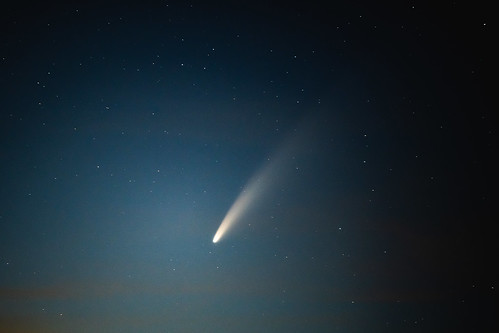Following my previous attempts at photographing Comet NEOWISE, I went out again late on Sunday evening. With Nautical Twilight ending at just after 11:00pm, I headed off just before then to see if the visibility would be decent for another stab at photographing NEOWISE.
I was keen to get out on Sunday because the weather forecast for London was poor for the next few days, with lots of cloud cover. This might be my last opportunity to view for a while, even as the comet’s visibility improves in the late evening. I was looking in the northwest sky, and when I finally spotted the comet, it wasn’t all that clear. It was slightly masked by clouds and I was surprised that I’d managed to pick it out at all. In fact it was much closer to due north than I’d been expecting – although I believe over the next few nights as it appears higher in the sky, it’ll move further towards northwest when it appears post-11:00pm.
I made a few “learnings” tonight.
First of all, I remembered that there is the “500 rule” for astrophotography. More particularly, I realised on close examination of my images that I was seeing star trails with my exposures of more than a few seconds – I’d begun by capturing shots up to 30 seconds hoping to get as much light captured as possible. But with a zoom lens, the movement of the stars even over 30 seconds leaves short star trails, and that included the comet.
I ended up settling on 4 second exposures for my 200mm lens which had been designed for a crop sensor camera (my A7iii takes this into account and crops down). If I retrospectively apply the rule, which I couldn’t remember out in the field – 500 x 1.6 crop / 200 mm lens = exposure in seconds – I get 4 seconds. So I ended up in the right place via experimentation!
I also spent a bit more time making sure I had as tight focus as possible, and this batch of pictures were much improved as a result.
Finally, I didn’t use my teleconverter. As it is, my 70-200mm lens is for an A-mount Sony camera, whereas my A7iii is an E-mount, so I have an adaptor which doesn’t help speed focusing up. Another issue is that my teleconverter costs two stops of light. So not using it means I was able to shoot at f/2.8, and 200mm is sufficiently zoomed in to get good images.
I am pleased with my results! Note: I’ve post-processed them with Adobe Lightroom Classic.
Overall, I would note that over the hour or so I was shooting, the comet moved towards north, and got easier to see the longer I waited. Part of that may have been due to clouds clearing however. It still wasn’t as bright as it had been very early in the morning, but I got better photos. Note that the angle of the tail changes over time, with the tail appearing at 45 degrees in these pictures compared to being vertical in the early morning.
If it’s not too cloudy where you are over the coming days, get outside, somewhere nice and dark, and try to see it.
Later: Just a shame that I don’t live near a nice landmark to line up a photo like this one!




